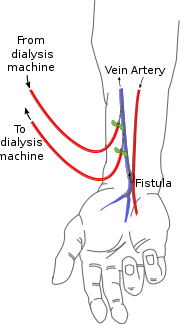
Cimino fistula
Encyclopedia

Hemodialysis
In medicine, hemodialysis is a method for removing waste products such as creatinine and urea, as well as free water from the blood when the kidneys are in renal failure. Hemodialysis is one of three renal replacement therapies .Hemodialysis can be an outpatient or inpatient therapy...
. It is typically a surgically created connection between an artery
Artery
Arteries are blood vessels that carry blood away from the heart. This blood is normally oxygenated, exceptions made for the pulmonary and umbilical arteries....
and a vein
Vein
In the circulatory system, veins are blood vessels that carry blood towards the heart. Most veins carry deoxygenated blood from the tissues back to the heart; exceptions are the pulmonary and umbilical veins, both of which carry oxygenated blood to the heart...
in the arm, although there have been acquired arteriovenous fistulas which do not in fact demonstrate connection to an artery.
Theoretical basis
Surgically created AV fistulas work effectively because they:- Have high volume flow rates (as blood takes the path of least resistancePath of least resistanceThe path of least resistance describes the physical or metaphorical pathway that provides the least resistance to forward motion by a given object or entity, among a set of alternative paths. The concept is often used to describe why an object or entity takes a given path.In physics, the path of...
; it prefers the (low resistance) AV fistula over traversing (high resistance) capillary beds). - Use native blood vessels, which, when compared to synthetic grafts, are less likely to develop stenosesStenosisA stenosis is an abnormal narrowing in a blood vessel or other tubular organ or structure.It is also sometimes called a stricture ....
and fail.
History
The procedure was invented by doctors Cimino and Brescia in 1966. Before the Cimino fistula was invented, access was through a Scribner shunt, which consisted of a Teflon tube with a needle at each end. Between treatments, the needles were left in place and the tube allowed blood flow to reduce clotting. But Scribner shunts lasted only a few days to weeks. Frustrated by this limitation, Dr. James E. Cimino recalled his days as a phlebotomistPhlebotomist
Phlebotomists are individuals trained to draw blood from a live person or animal.Phlebotomists collect blood primarily by performing venipuncture and, for collection of minute quantities of blood, fingersticks. Blood may be collected from infants by means of a heel stick...
(blood drawer) at New York City
New York City
New York is the most populous city in the United States and the center of the New York Metropolitan Area, one of the most populous metropolitan areas in the world. New York exerts a significant impact upon global commerce, finance, media, art, fashion, research, technology, education, and...
's Bellevue Hospital in the 1950s when Korean War
Korean War
The Korean War was a conventional war between South Korea, supported by the United Nations, and North Korea, supported by the People's Republic of China , with military material aid from the Soviet Union...
veteran
Veteran
A veteran is a person who has had long service or experience in a particular occupation or field; " A veteran of ..."...
s showed up with fistulas
Arteriovenous fistula
An arteriovenous fistula is an abnormal connection or passageway between an artery and a vein. It may be congenital, surgically created for hemodialysis treatments, or acquired due to pathologic process, such as trauma or erosion of an arterial aneurysm....
caused by trauma. Cimino recognized that these fistulas did not cause the patients harm and were easy places to get repeated blood samples. He convinced surgeon Kenneth Appell to create some in patients with chronic kidney failure
Chronic renal failure
Chronic kidney disease , also known as chronic renal disease, is a progressive loss in renal function over a period of months or years. The symptoms of worsening kidney function are unspecific, and might include feeling generally unwell and experiencing a reduced appetite...
and the result was a complete success. Scribner shunts were quickly replaced with Cimino fistulas, and they remain the most effective, longest-lasting method for long-term access to patients' blood for hemodialysis today.

